Updated 03-20-22. Hu tieu (Hủ Tiếu) is a noodle-in-soup dish very popular among Vietnamese especially in the South. No doubt you have heard of this Southern Viet creation, and there are many non-Viet already discovering it. No it's not pho, and what are we doing talking about hu tieu in a pho blog anyway?
The reason is there are some confusions about what hu tieu is and what it is not, due to the common noodles sometimes used between the two. Plus I've always wanted to give my own take on hu tieu so here's my chance to put hu tieu in its rightful place.
Hủ Tiếu Defined
Hu tieu? Not so simple to explain. There are already excellent sources that you can find on hu tieu, including "Hu Tieu Nam Vang (Phnom Penh Noodle Soup)" by Andrea Nguyen, and hu tieu page on Noodlepie.com, from the Wayback Machine, plus a host of others. Both of these are informative and entertaining. Still the uninitiated needs something a little more fundamental, at the most basic level.
Here it is, at the most basic level,
- There are hu tieu the noodles (bánh hủ tiếu,) and then there are hu tieu the dishes,
- Hu tieu dishes may be served dry (fried) or wet (soup) style. But, there is another variety: the wet style served with broth hot on the side in separate bowl, essentially making the dish "dry" until you pour the broth in.
You go to the supermarket to buy a package of hu tieu noodles and other ingredients to prepare the meal yourself, but in a restaurant you will be served hu tieu as the completely prepared dish. Confusing I know. Vietnamese tend to use the same word for different things and this is one of those instances. As you may notice on a typical menu, you can order fried hu tieu or hu tieu in soup; 'dry' or 'soup' hu tieu, so to speak. So in your conversation about hu tieu, knowing which you're talking about (the noodle or the dish, and dry or soup) can be helpful. For a Vietnamese, it's always understood what is what and which is which.
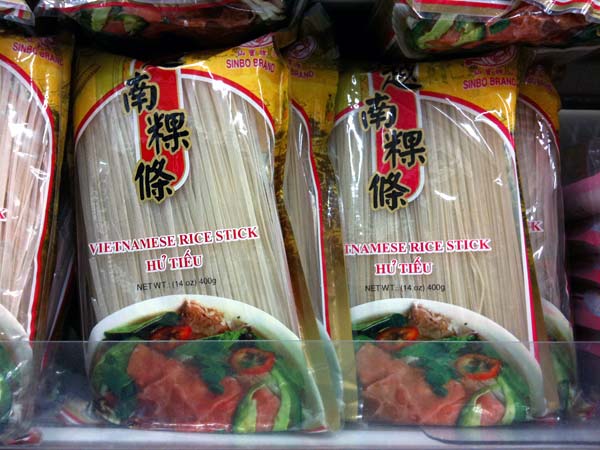 Hu Tieu The Noodles (Bánh Hủ Tiếu)
Hu Tieu The Noodles (Bánh Hủ Tiếu)
There is really only one kind of noodle that is called hu tieu noodle. Once cooked, it is the chewy, clear and somewhat sticky kind that is made of tapioca, not rice. On a shelf in a food market, at first glance it may look like banh pho noodle, just not as white in color, or maybe a thicker bún (vermicelli.) But unless it is specifically labeled "Hủ Tiếu," it isn't. Like banh pho noodles and bun, bánh hủ tiếu noodles can be purchase dry or fresh.
The Many Faces of Hu Tieu
Hu tieu the dish is really not a single dish at all. As demonstrated in the sources mentioned above, there are many varieties. The three most recognized types are Hu Tieu Nam Vang (hu tieu Phnom Penh style,) Hu Tieu My Tho (after the capital city of Tiền Giang Province, located in the Mekong Delta region of southern Vietnam,) and Hu Tieu Chinese style. [Update] The Chinese had a lot to do with hu tieu being in Vietnam in the first place, and as pointed out by Andrea Nguyen and Sue in the comment #1 below, Chinese-Cambodian brought the dish from Cambodia (hence the Phnom Penh style,) and Vietnamese borrowed it and made their own Viet versions.
In between the three there are countless other versions of hu tieu that are created in many areas of southern Vietnam, each making use of the available local ingredients. Hence you have pork hu tieu, seafood hu tieu, shrimp hu tieu, or anything else the cooks desire to create. The amazing thing is with such diversity and creativity, diners from outside the area would recognize a bowl of hu tieu as a legitimate bowl of hu tieu when encountered!
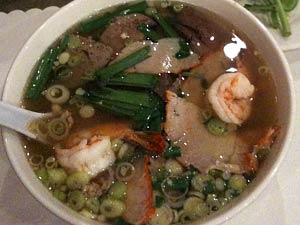 The common thread that seems to connect these hu tieu variations are the key elements, such as pork-based soup broth, ground pork (the finer the better,) Chinese celery, sauteed garlic and shallots and a few others, to maintain hu tieu's distinctive bite and taste. Hu tieu is one of those rare yet beautiful noodle dishes that change from place to place, utilize a variety of different ingredients depending on the preparer, and are accepted with the same naming convention no matter where they end up. Interestingly, hu tieu versions that are based on chicken or beef ingredients are rarely found. Beef is already the king in pho, and chicken can be found in pho and many bun dishes, so I think everything works out just fine and everyone is happy.
The common thread that seems to connect these hu tieu variations are the key elements, such as pork-based soup broth, ground pork (the finer the better,) Chinese celery, sauteed garlic and shallots and a few others, to maintain hu tieu's distinctive bite and taste. Hu tieu is one of those rare yet beautiful noodle dishes that change from place to place, utilize a variety of different ingredients depending on the preparer, and are accepted with the same naming convention no matter where they end up. Interestingly, hu tieu versions that are based on chicken or beef ingredients are rarely found. Beef is already the king in pho, and chicken can be found in pho and many bun dishes, so I think everything works out just fine and everyone is happy.
Hu Tieu The Dishes - Dry or Soup?
As if that weren't enough variations, you can also have 'dry' and 'soup' hu tieu. I won't go much more into the dry hu tieu dishes (just as I won't go much into the 'dry pho' dishes on this site - ha, bet you didn't know such things exist!), except to say that these delicious dishes come mainly as either pan-fried or stir fried hu tieu (hủ tiếu áp chảo or hủ tiếu xào, respectively.) Meat ingredients run the gamut from beef, chicken, pork, and their innards, to shrimp, scallop, squid, and crab.
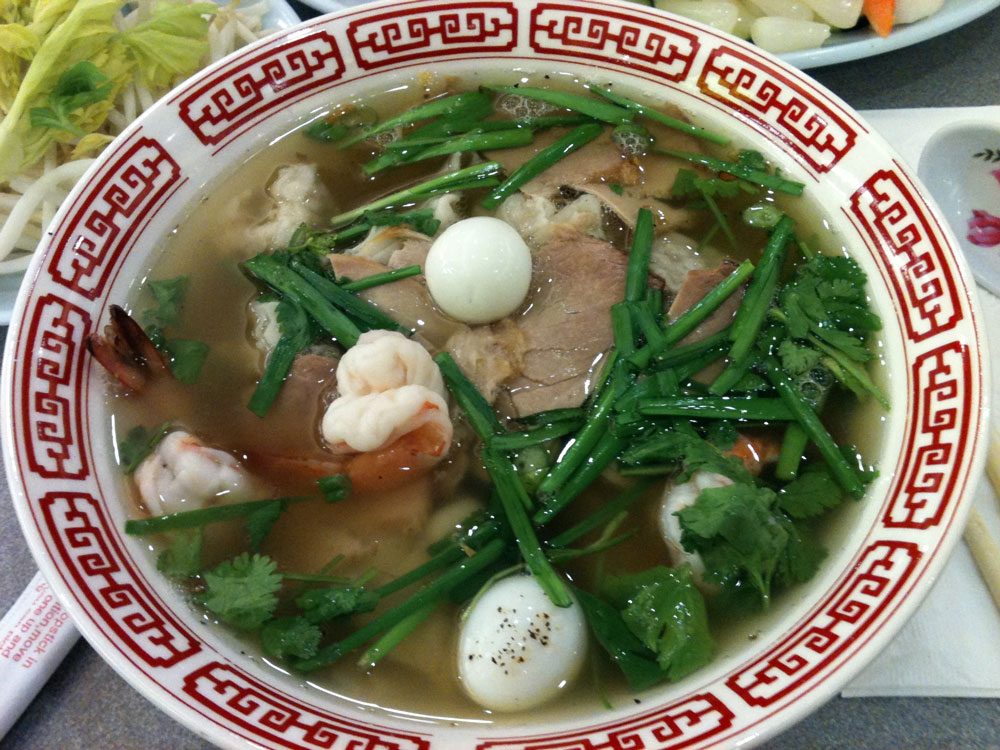 So there you have the ultimate challenger to my beloved bowl of pho. You can run into hu tieu everywhere in the South, they take on many shapes and forms, and they all taste yummy. To put hu tieu (the soup kind) in perspective, here are some hu tieu 101s for you:
So there you have the ultimate challenger to my beloved bowl of pho. You can run into hu tieu everywhere in the South, they take on many shapes and forms, and they all taste yummy. To put hu tieu (the soup kind) in perspective, here are some hu tieu 101s for you:
- Hu tieu dishes can use different noodles. You can have banh hu tieu noodles, banh pho noodles, or thin Chinese egg noodles (called mì in Vietnamese,) and the dish you order is still called hu tieu.
- When you order hu tieu, it's acceptable to mix banh pho noodles and thin egg noodles in the same hu tieu bowl. In this case it is called hủ tiếu mì and many restaurants actually have this on their menus.
- Probably from the Chinese influence, hu tieu can also have Vietnamese wonton (hoành thánh, which is better than Chinese wonton in my opinion) right in the bowl with the noodles. Hoành thánh is very universal; as long as you have a pork-based soup noodle dish like hu tieu, it will go with hoành thánh.
- Good hu tieu restaurants will serve you the option of hu tieu with the hot soup on the side in another bowl. Some people will eat the two separately, though most will just put the hot soup in over the noodles before digging in. This gives the best (or chewiest, or least cooked) noodle experience. This is rarely done with the Chinese egg noodles as they need to be thoroughly cooked.
I'm sure there are still lingering questions about Vietnamese hu tieu, but I think this will help begin to clear up some confusions about what hu tieu is and how it may be enjoyed, but more importantly, how it differs from pho. For a Vietnamese it's pretty much common knowledge. But for others it's probably been one contradiction after another where seemingly different dishes are all called Hủ Tiếu! Hopefully you can now order your hu tieu with confidence and then enjoy it with peace of mind. Please drop me a comment below. And take this poll below. Thanks.

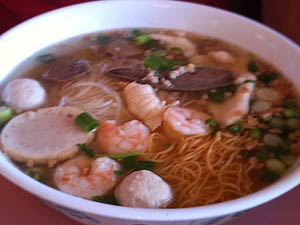
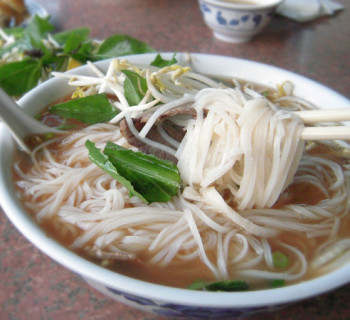
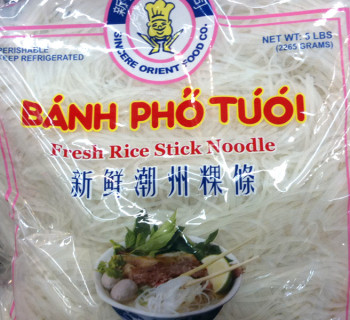

Hu tieu is not just Chinese influenced, hu tieu was brought over to Vietnam from Chinese immigrants living in Cambodia. So it’s actually a Chinese creation (or Chinese-Cambodian creation, to be more specific).
Hi Sue,
Your comments are right on. I didn’t want to go into the history of hu tieu, but to mainly stay strictly with what hu tieu itself is in this article. But what you pointed out is important so I’ve updated it. Thanks for pointing it out.
No problem. I find the history of food around the world so interesting 🙂
Yeah I think history of food and people and how they influence each other is always fascinating. I know I barely scratch the surface even with just Vietnamese pho. Happy noodling 😎
if anything, Hu Tieu aka “Kuy Tieu Phnom Penh” is a cambodian noodle dish. Also there are many cambodian living in southern vietnam since it was once part of cambodia.
Hu Tieu is a great dish and if anyone wonders how to make it at home here is a recipe I found: http://findvietnam.com/recipes/hu-tieu-recipe-vietnamese-noodle-soup-including-lots-pork-shrimp-garlic-shallot/
I think lovingpho should actually list the recipe too as its kinda easy to have it at hand but anyway I provided a link 🙂
Hi Sara: Thanks for sharing this hu tieu recipe. It’s a good recipe, and the instructions are clear and easy to follow. I’ll add it to the body of the article soon.
Hu Tieu is actually only about 30 percent tapioca and the rest rice flour. At least that is what they said at the factory tour in Can Tho, Vietnam in the Mekong Delta.
@Rudra: Thanks for sharing. The noodle used in hu tieu depends on specific regions in Vietnam. As mentioned in my article, it can use egg noodle with Chinese influence, or banh pho noodle in many Southern areas. Obviously the factory you mentioned uses tapioca and rice flour, which is are both common ingredients to make banh pho and other “rice” noodle like “bún” and “bánh hỏi”. So it’s good to know this factory makes the noodle with 30/70 mix (unfortunately no name or brand was given), but I’m sure other manufacturer may have a different mix, depending on how they want their texture and taste to be.
I have a question. There are two unrelated Hủ Tiếu restaurants where I live and both have “Ky (or Kee) Mì Gia” in their names. Thanks to this article I know what the “Mi” means but does anyone know what the rest of it or the phrase refers to?
@C: Mì Gia literally translates to “noodle house”. It’s a part of many Chinese and Viet noodle restaurants’ names. Ky or various properly written forms of it (Ký or Kỳ) is a Vietnamese name, Kee is a Chinese name written in English, as there is no words in Viet language with a double ‘e’ (ee).
Not sure about the specific places you mentioned, but normally Ky or Kee should be part of a 2- or 3- word names. Hope this helps.
Uhh, I read it is of Chinese influence. Specifically Teochew or for Vietnamese reference “Triều Châu.” They has a huge diaspora, especially throughout Southeast Asia. This is a reason why a lot of mixed Chinese , especially in Vietnam, Thailand, Laos and Cambodia are mixed with Triều Châu. Also why there’s “Hủ tiếu Triều Châu.”
@Orlando Dao: Fair comment. I think if we go back far enough, we’d find that most everything would point back to some Chinese influence or Chinese origin. China as a country and a people had the most advanced and developed culture, technology and way of life in the whole Asia region. They even call themselves the center of the world even to this day. Compared to the Chinese civilization, most of the surrounding areas (in all directions: north, east, south, west) are considered less civilized peoples in small tribes with less organization, no technology, cultures, etc. Vietnam, Thailand, Laos and Cambodia would fall into this group. I’m sure China would love to incorporate all these “little” countries as part of China as they have at times in the past. Chinese influence across Asia and the world was and is so extensive that any type of noodle as a food would have originated from China ultimately. No argument there.